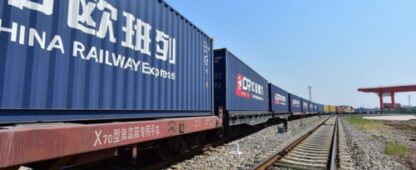In the first half of 2025, the China-Europe Railway Express experienced a notable decline in container volume, dropping 7% from the same period last year, largely attributed to weakening demand from Russia and ongoing trade disruptions linked to geopolitical tensions.
Despite efforts to explore alternative routes and adjust freight rates, the impact of the Russia-Ukraine conflict continues to pose significant challenges for the railway corridor, which has traditionally relied heavily on Russian trade.
In the first half, the China-Europe Railway Express sent a total of 964,000 standard containers, a year-on-year decrease of 7.4%; it operated a total of 9,310 trains, a year-on-year decrease of 3.3%, according to data released by the China State Railway Group.
In particular, outbound routes operated 4,500 trains, a year-on-year drop of 16.55%; inbound routes operated 4,854 trains, an increase of 13.1%. Outbound trains sent 462,700 standard containers, down 20.3% year-on-year, while inbound trains sent 501,300 standard containers, an increase of 8.7% year-on-year, showed the data.
The number of trains operated and the volume of standard containers sent by the China-Europe Railway Express have shrunk year-on-year for six consecutive months. In June, the China-Europe Railway Express operated 1,580 trains, a year-on-year decrease of 3.3%; sending 164,600 standard containers, a year-on-year drop of 8.6%. Among them, outbound trains operated 810 trains, a year-on-year decrease of 13.4%; sending 85,000 standard containers, a year-on-year decrease of 15.9%.
Previously, the decline in February this year was severe due to Russia’s restrictions and seizures of Chinese goods. According to data from the group, in February the China-Europe Railway Express operated 422 outbound trains, sending 48,300 standard containers of goods, both slumping by 43.4% year-on-year, and the freight rate fell by one quarter month-on-month to $4,500 per standard container.
From March onwards, the freight rates of the China-Europe Railway Express were adjusted, with railway authorities lowering the minimum shipping standard for the China-Europe Railway Express so that shipments with as few as 45 containers could be dispatched, leading to some recovery in business volume compared to February.
Currently nearly 90% of the China-Europe Railway Express business is related to Russia, with business to Europe accounting for only about 10%.
Yang Jie, general manager of Euro-Asia International Freight Forwarding (Suzhou) Co., Ltd., said that after the Russia-Ukraine conflict, business to Europe has mainly been constrained by geopolitical factors, coupled with Europe’s economic downturn leading to insufficient demand, which has seen little change in the past two years.
The impact of tariffs has been limited, and the decline in the China-Europe Railway Express volume in the first half was mainly due to the Russia-Ukraine conflict causing a drop in Russia’s purchasing power and China’s export restrictions on Russia.
A person from China Railway United International Container Company said in April that the China-Europe Railway Express is facing increasing “bottleneck” problems, including recent Russian inspections of goods from China. Currently, the China-Europe Railway Express is exploring new trade routes that bypass Russia, such as southern routes and cross-Caspian rail-road combined transport, aiming to seek new trade channels to Europe.
Yang Jie said that looking at June alone, Russian companies still face problems caused by the Russia-Ukraine conflict such as tight government finances, difficulties in corporate financing, decline in consumer purchasing power, weakening demand, and inventory accumulation.
He also mentioned that Russia traditionally enters a logistics off-season from June to August, during which many employees take vacations and companies reduce production, operation, and purchasing activities, weakening demand for imported goods.
According to the latest data from China’s General Administration of Customs, in the first five months of 2025, the total import and export trade between China and Russia was about $88.796 billion, a year-on-year decrease of 8.2%. Among them, China’s exports to Russia fell 6.6% year-on-year, and imports from Russia fell 9.5%. During the same period, China’s total import and export trade with Europe, including Russia, was about $481.614 billion, down 3.9% year-on-year. Among them, China’s exports to Europe increased by 5.1% year-on-year, while imports from Europe fell by 16%.
Yang expects that the decline in China-Europe Railway Express freight volume may only improve after the Russia-Ukraine conflict ends.
Since the unified branding in 2016, the China-Europe Railway Express maintained a high-speed growth trend for many years until the end of 2024. In 2024, the China-Europe Railway Express still recorded double-digit growth for the whole year. Last year, a total of 19,392 trains were operated, an increase of 10.7% year-on-year, including 10,546 outbound trains, up 12.9%, and 8,846 inbound trains, up 8.1%. A total of 2.0772 million standard containers of goods were sent, up 9.2% year-on-year.
In sharp contrast to the China-Europe Railway Express, in the first half of the year, the Central Asia Railway Express’s operating volume and standard container shipments both exceeded those of the China-Europe Railway Express, maintaining double-digit year-on-year growth for six consecutive months. According to data from the National Railway Group, in the first six months of 2025, the Central Asia Railway Express operated a total of 7,349 trains, a year-on-year increase of 24.7%, and sent 565,200 standard containers, a huge increase of 31.8% year-on-year.

